How to Write a Song in Ten Steps
How to Write a Song in Ten Steps
by Robin Frederick Check out my books at Amazon.com.
Whether you want to write songs to pitch to music publishers, TV shows and commercials, or record them yourself as an artist, here’s a songwriting method that will help you get your message across and make sure your listeners stay involved from beginning to end. Of course, this is just one approach to songwriting but it’s used by many songwriting pros and it works.
 1. Start with the title. Create a phrase of one to six words that sums up the heart of your song’s message. Try using an image or action word in your title to give it energy and interest. For more tips on song titles read Write a Memorable Title or watch this video.
1. Start with the title. Create a phrase of one to six words that sums up the heart of your song’s message. Try using an image or action word in your title to give it energy and interest. For more tips on song titles read Write a Memorable Title or watch this video.
 2. Make a list of questions suggested by the title. Start by asking yourself what you want to say about your title and what you think your listeners might want to know. Make list of questions. Your list might include: What does the title mean? How do you feel about it? What happened to cause this? What do you think or hope will happen next? You’ll need three to four questions. Check out this video for more information.
2. Make a list of questions suggested by the title. Start by asking yourself what you want to say about your title and what you think your listeners might want to know. Make list of questions. Your list might include: What does the title mean? How do you feel about it? What happened to cause this? What do you think or hope will happen next? You’ll need three to four questions. Check out this video for more information.
 3. Choose a song structure. Currently, the most popular structure is: Verse / Chorus / Verse / Chorus / Bridge / Chorus. Many recent hits add a short section called a “pre-chorus” or “lift” between the verse and chorus to build anticipation. Here’s a tip that will tell you more. Or watch this video to learn the basics.
3. Choose a song structure. Currently, the most popular structure is: Verse / Chorus / Verse / Chorus / Bridge / Chorus. Many recent hits add a short section called a “pre-chorus” or “lift” between the verse and chorus to build anticipation. Here’s a tip that will tell you more. Or watch this video to learn the basics.
 4. Answer one question in the chorus and one in each verse. Select the question you want to answer in your chorus. Look for images and action words to bring your answers to life. What emotion are you describing? How does it make your body feel? Is it warm or cold? Dark or light? If you get too poetic, add a line that makes a clear statement so listeners don’t get lost. Read more about adding emotion to your lyrics here.
4. Answer one question in the chorus and one in each verse. Select the question you want to answer in your chorus. Look for images and action words to bring your answers to life. What emotion are you describing? How does it make your body feel? Is it warm or cold? Dark or light? If you get too poetic, add a line that makes a clear statement so listeners don’t get lost. Read more about adding emotion to your lyrics here.
 5. Find the melody in your lyric. Choose the lines you like best for your chorus. Say them out loud. Now say them again with LOTS of emotion. Exaggerate the emotion in the lines. Notice the natural rhythm and melody of your speech when you say the lines with lots of feeling. This is the beginning of your chorus melody. Play with it until it feels comfortable. Here’s more info on using your lyric to create a melody.
5. Find the melody in your lyric. Choose the lines you like best for your chorus. Say them out loud. Now say them again with LOTS of emotion. Exaggerate the emotion in the lines. Notice the natural rhythm and melody of your speech when you say the lines with lots of feeling. This is the beginning of your chorus melody. Play with it until it feels comfortable. Here’s more info on using your lyric to create a melody.
 6. Begin to add chords to your chorus melody. Try a simple, repeated chord pattern. Play with the melody and chords until you find something you like. Record a rough vocal – even if it’s only on your iPhone. Just be sure you get it down so you don’t forget it. You’ll find a several chord progressions you can use in this post. Just scroll down to the section on Chord Progressions.
6. Begin to add chords to your chorus melody. Try a simple, repeated chord pattern. Play with the melody and chords until you find something you like. Record a rough vocal – even if it’s only on your iPhone. Just be sure you get it down so you don’t forget it. You’ll find a several chord progressions you can use in this post. Just scroll down to the section on Chord Progressions.

7. Choose a question to answer in your first verse. Make it one that will draw the listener into the situation. Go through Steps 4 – 6 with you verse lyric and melody.
 8. Connect your verse and chorus. After you have a verse and chorus create a transition between them. You may need to raise or lower your verse melody or change the last line to get to your chorus smoothly. TIP: Chorus melodies are usually in a higher note range than verses. When we get emotional our voices tend to rise. The chorus is the more emotional part of your song so it’s higher, while verses add information about the situation.
8. Connect your verse and chorus. After you have a verse and chorus create a transition between them. You may need to raise or lower your verse melody or change the last line to get to your chorus smoothly. TIP: Chorus melodies are usually in a higher note range than verses. When we get emotional our voices tend to rise. The chorus is the more emotional part of your song so it’s higher, while verses add information about the situation.
 9. Build your second verse and bridge. Choose another of your questions to answer in Verse 2. Proceed through Steps 4 – 6. Your second chorus will have the same melody and lyric as your first chorus. You are now almost finished with your song. You just need to add a bridge. The bridge section adds a peak emotional moment to your song, a realization, or an “aha!” moment. Try two or three lyric lines that give the listener the best insight you can, or sum up what you hope will be the outcome. The melody should be different from both verse and chorus. Try using a chord you haven’t used before or changing the phrase lengths or motion of the melody. A bridge isn’t a requirement but it can add a lot of strength to your song.
9. Build your second verse and bridge. Choose another of your questions to answer in Verse 2. Proceed through Steps 4 – 6. Your second chorus will have the same melody and lyric as your first chorus. You are now almost finished with your song. You just need to add a bridge. The bridge section adds a peak emotional moment to your song, a realization, or an “aha!” moment. Try two or three lyric lines that give the listener the best insight you can, or sum up what you hope will be the outcome. The melody should be different from both verse and chorus. Try using a chord you haven’t used before or changing the phrase lengths or motion of the melody. A bridge isn’t a requirement but it can add a lot of strength to your song.
 10. Record your song. A simple piano/vocal or guitar/vocal can often be the most effective emotional statement of your song. If you wrote a Rock song, do an “unplugged” version. You don’t need lots of strings and synths – in fact, these can detract. Practice both the instrumental and vocal parts until you are comfortable with every chord, every note, every word. The less you have to focus on playing or singing, the more you can focus on the emotion in the song. Try singing it as if you are speaking it to someone. Record for short periods then take a break. Keep the song and the emotion fresh! Here’s a tip that will give you more ideas on how to record a rough demo.
10. Record your song. A simple piano/vocal or guitar/vocal can often be the most effective emotional statement of your song. If you wrote a Rock song, do an “unplugged” version. You don’t need lots of strings and synths – in fact, these can detract. Practice both the instrumental and vocal parts until you are comfortable with every chord, every note, every word. The less you have to focus on playing or singing, the more you can focus on the emotion in the song. Try singing it as if you are speaking it to someone. Record for short periods then take a break. Keep the song and the emotion fresh! Here’s a tip that will give you more ideas on how to record a rough demo.
Now that you know how to write a song in ten steps, here are some Song Starters – titles, themes, chord progressions, and more – to get you going.
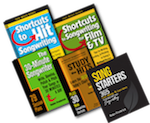 The posts on this website are based on my songwriting books. You'll find hundreds of useful, real world tips and techniques to get your creative ideas flowing and help you craft songs that work for today's music market. Find out more about all my print and eBooks on my Author page at Amazon.Copyright Robin Frederick. All rights reserved. Request permission to reprint.
The posts on this website are based on my songwriting books. You'll find hundreds of useful, real world tips and techniques to get your creative ideas flowing and help you craft songs that work for today's music market. Find out more about all my print and eBooks on my Author page at Amazon.Copyright Robin Frederick. All rights reserved. Request permission to reprint.
Search the site…
ROBIN’S BOOKS
Robin’s Lyric Course
Top Posts & Pages
BEST SELLER!!!
5 STARS AT AMAZON.COM
HOTTEST MARKET
THE FASTEST GROWING
MARKET FOR SONGS!
Robin’s new book!!!


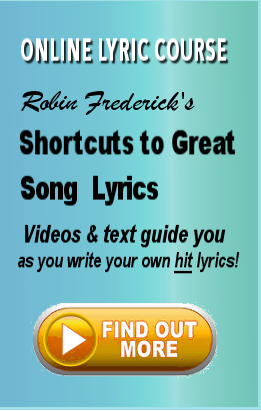
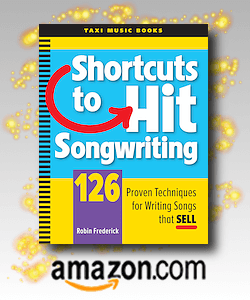

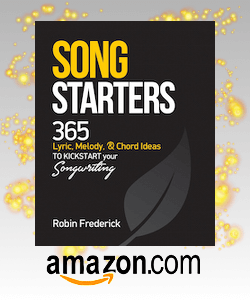
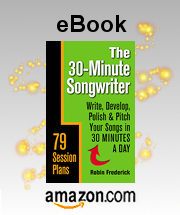


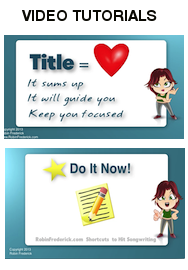


Comments
Post a Comment